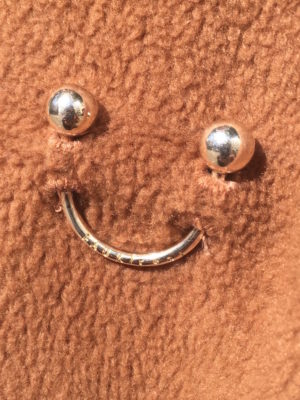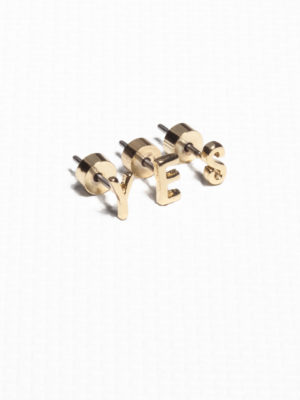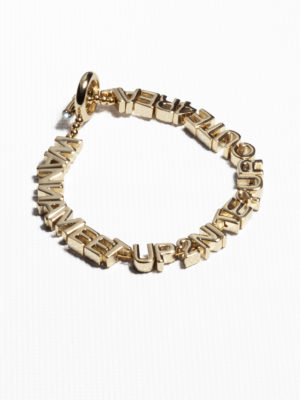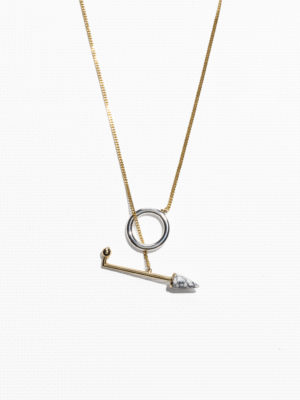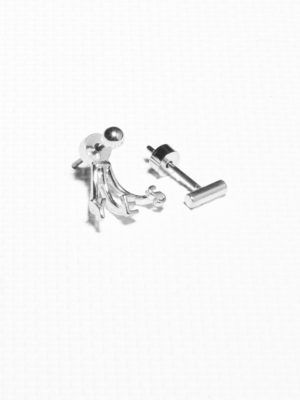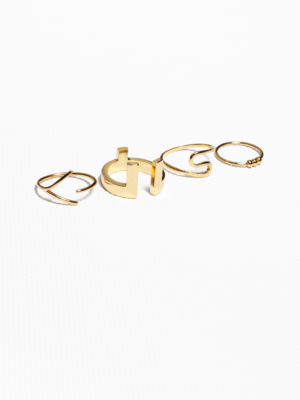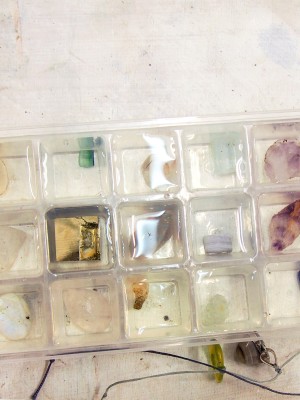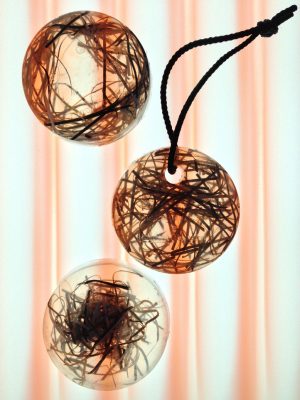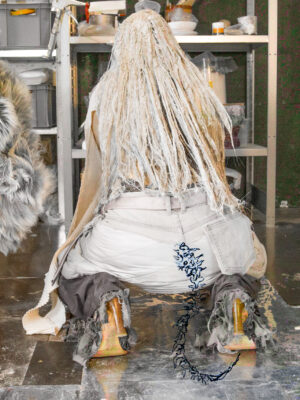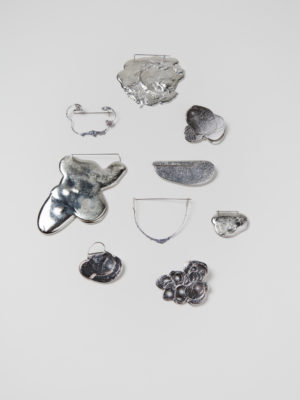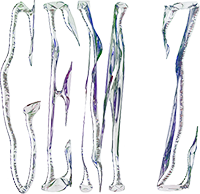Current Obsession have been admiring their numerous collaborations from afar, and reached out to Mari—who was at that moment in Berlin—for this particular edition of the Paper for a candid conversation about life between art genres and success between continents.
Marina: A while ago on Instagram I saw you had this surreal exhibition, with your work sitting on these insane furniture pieces made of fur, and it was super unclear, but fascinating. Tell me about this project.
Mari: Those fur things were actually not ours; we had a joint show with BLESS. They’re based in Berlin and Paris, and they are in the same field. But they’ve been doing this for longer than us, between fashion and design and art, and they made the furniture series for an architectural biennial in Chicago. It was a perfect combination because it was so surreal; it was kind of playing with your eyes. People really loved it.
FAUX/real doesn’t want to only sell jewelry, what’s the point of it? You can go to H&M and Zara and get the cheapest cool jewelry. So as a designer it’s a challenge; we don’t just want to focus in on the retail purpose of the jewelry, we want experience, we want to challenge the viewers.
Also, when you own the object, that object’s purpose changes. We can’t decide the purpose of the object anymore if [someone else] owns it.
Well, when it is taken care of it becomes an heirloom that means something, it is a mark of an important event in someone’s life and there can be a very special connection.
Exactly. That I cannot create. I need somebody else’s experience or life or view or memories attached to the objects we make. So it’s kind of like collaboration with the wearer.
I know you worked with & Other Stories. How was that for you?
That was actually an exciting experience. At first we were very surprised that they approached us, because we thought that fast fashion is the enemy.
The funny thing is that a lot of fast-fashion brands copy our designs, but that’s obvious. A couple of our friends that do design consulting for those big companies constantly tell us they see pictures of our pieces in their mood boards. And we are like … that’s the world we live in. We just have to go on and make new ideas. We have to just do better things than them.
But when & Other Stories approached us, they showed full respect to us and to what we are doing. They never gave us a budget or other limits; they just gave us the theme. They wanted us to tell a love story. They really wanted to collaborate with jewelry designers that do something different from normal, commercial jewelry. So it was a very fun process. We ended up with lesbian couples and their love story—an LGBT theme that love is for everybody. And breaking from the old-fashioned way of thinking around who is a male and who is a female, or the power balance—or two men, two women—like, who cares at the end? But also we needed to have a twist in the story, so we tried to add a dark side. But it was really fun: the theme and the production, the sample making took one year. They flew me in several times to Stockholm.
Due to their scale, their production numbers must be very high, right?
We requested that it be a limited edition. They only produced 50 [of each product]. And when they sold that, that’s it. We had that contract. It was only for a couple stores, London, New York, Paris, and I think Stockholm. The collection was launched for Valentine’s day due to the love story theme and only sold for a month to make it extra exclusive, and that was it. Because what’s the point working with these big companies and giving them designs?
Was it a problem for them that you wanted it limited edition?
No, they said, whatever we wanted.
Can you give me an example of another collaboration that was very experimental, where you had to really push yourselves.
A challenging one was a collaboration we did with the conceptual artist Anicka Yi, a New York–based artist. She’s an amazing artist. It was actually a personal project, so she approached me and we made sculptures together. But when you’re making sculptures with another artist, there’s always an ego clash and somebody has to take control of it. Since it was her solo show, I needed to listen to her very personal stories behind the theme and inspirations, so was kind of sucked into her deep world. That was emotionally a really tiring process, sitting with this very strong-minded person, and we had to clash and discuss. We collaborated on three sculptures for the show. There are so many ideas packed in those pieces.
Sometimes I think the ideal collaboration is when someone throws the theme at us and we do whatever we want. Then we work from that, instead of doing every single process together.
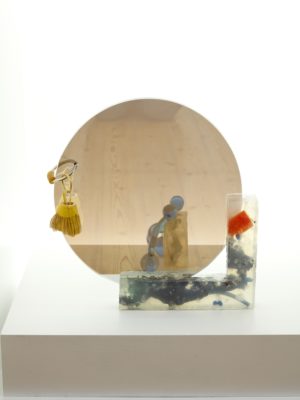
But between the two of you, with Louis, it’s also a collaboration.
How does that work?
It’s hardcore, it’s really hardcore our collaboration, because we are completely different. But that’s what FAUX/real is, I think. He’s Colombian and I’m Japanese so culture-wise, it’s completely different. And what we like is different. We were very connected with the music scene, we used to do collaborations at parties with musicians and DJs, but our music taste is completely different so when we make the playlists together it’s like out of control and weird—two different styles stuck together.
Actually, we both are not jewelers. That’s the crazy part, that we don’t like jewelry as just jewelry, we don’t have a background in jewelry-making. Louis was making custom-made jewelry and accessories, crazy pieces for musicians like Björk in the early 2000s. I came from the styling world. I was a fashion stylist and then I was a fashion editor for an art magazine in Paris. They just needed to have someone in New York to do a lot of commission work with artists, so I was the liaison between artists and the magazine.
Louis and I had a common friend and we were always talking and doing crazy things together. We would just freestyle, make whatever he wanted to make, to make sense. So we have a different taste on everything and constantly have to meet in the middle, but somehow we have a common something, and that’s the beauty, I think.
Mari, you reside in Berlin now, could you tell me why?
I’ve spent a lot of time in Berlin over the last ten years, I have a lot of friends here and I always liked the place. It’s the opposite of New York basically. You can really settle down—there’s more space, it’s more relaxed. So that’s kind of the reason to be there, to be half-and-half, to have wider possibilities. I’ve been living between Berlin and New York month-to-month for two years now. It is intense, but things are always happening in New York so I have to be there, to be present …
Eventually I’d like to do more collaboration with artists in Berlin or in Europe. I can bring things from New York and I can mix in things from Europe—make a new platform here. There are some interesting conversations I can maybe start. Because I just realized that the New York scene and the European scene are at certain points connected but a lot of things have a distance.
This is what I wanted to ask you about, the differences would be an interesting subject. Current Obsession is also a European platform that has been invited to contribute to something that’s happening in New York, and we do see a lot of differences. For example, it feels like in Europe you can be less financially successful as an artist or designer, but you can still be okay financially because you can have a lot of support from the government—there are a lot of residences, a lot of grants. And this is a good thing but it’s also a trick, because a lot of people have this idea of themselves that they are successful and maybe they’re not. But then again in the United States you have to prove yourself financially and then you’re good. So I’d like to hear from you what your observations are on that.
In Europe, financial pressure is off. You can do what you believe in, which is nice, the space and freedom you have is beautiful. I think that’s the ideal situation for all creators. But there are a lot of European designers who have gotten lazy because they don’t need to work that hard to gain that much, and then it becomes kind of hobby level, like they are hobby artists or hobby designers. And I think, what’s the point of doing this? But that’s so mean to say, everybody has a different idea of what they’re doing so, I shouldn’t judge other designers for what they’re doing. But if you’re making things and only three people like it, it’s a little bit lazy.
There are pros and cons to both sides. New York has a financial pressure that is a source of energy. At the same time it’s hard to keep that pure creativity there, it’s almost impossible. You always have to think about the commercial aspect of how to make money, how to continue, how to pay your studio, how to pay your assistant. That pressure is always on your shoulders and it will probably influence your ideas as well. And that’s a real disadvantage we have in New York. So I think the best is to combine both. That’s what I’m trying to do now. But it’s a really interesting subject to bring up. Designers in Europe and designers in New York should have more platforms and community to really share opinions and discuss this issue.
“you don’t fix yourself in the art world, you don’t fix yourself in the design or fashion world, but you get all the elements of it and create something that everybody understands, but not everybody understands.”
How do you define success?
Success in America is purely money. That’s it. It’s all about how much money you make. It’s about amazing apartments, amazing studios, a hundred people you employ. If you’re huge, nobody really cares exactly what you are making, which is sad but I think that’s the reality of the design world in New York. It’s all about sales. In Europe I think there is more depth towards creation. I think people really look at what you make. It’s not about money but there is an old-fashioned way of judging people—where you show your work, where you have your work, and who you are connected with—it’s more conservative in a way. And that’s why I think I’m having a bit of a difficult time to have a mixed-media project In Europe. There are a lot of platforms, and of course people are open-minded, but the institutions and organizations are very conservative. They want you to be in one category: “Don’t mix jewelry and art” or “If you’re a jewelry artist you are a craftsman and you should stay there.” You know what I mean? That is Europe.
I wanted to know, who do you look up to?
Is there someone who was able to cultivate that interdisciplinarity in their work, maybe?
My strong influence is the artist Andrea Zittel, she mixes functional art and contemporary art. She can be [seen as] a designer, but she is an artist represented by galleries. Her question is all about day-to-day living objects, how they can influence your life. She makes a lot of furniture; she basically makes everyday objects but as an art form. It’s all about space and objects, and how to live with these objects.
She’s from New York but she moved to California, Joshua Tree, in the desert, and she made crazy houses and residencies and tried to make a community between designers and artists and craftsmen, where everybody can join and do research together. It’s a very communal type of thing. Yeah, her work is a very big influence for me. It’s really nice to be in a grey-zone—you don’t fix yourself in the art world, you don’t fix yourself in the design or fashion world, but you get all the elements of it and create something that everybody understands, but not everybody understands.
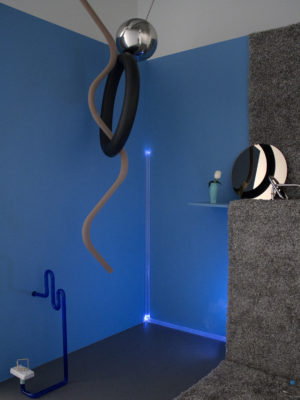
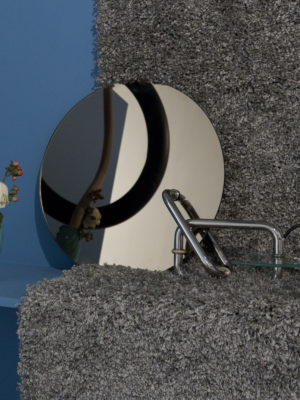
Yeah, like anything can be anything, right?
Things that everybody can relate to, yet cannot label …
Exactly, and I think that is a big inspiration for us. Also we are in this grey-zone. We don’t just define ourselves in the jewelry world, not just in the contemporary art world, and we are not in the high fashion world either, but we can work with these people, we do a lot of collaborations with these three worlds. We don’t belong anywhere, but it’s nice to have the flexibility.
Can you tell me what you’re working on now?
I want to make a functional sculpture performance project. I’m talking with dance companies in London and we will make sculptures, maybe bigger scale and smaller scale, and combine them with ballet-dance performance. So it’s going to be more theatre-world, and the idea is how sculpture functions with dance.
For another project, we are making a sculpture poster. It’s a poster but … how can I explain that? I will try. It’s a poster, and sculpture is on the poster. So it’s a flat and a 3-D kind of world. It’s related to [our recent] summer collection but it’s about past summer. So it’s all about the feeling of nostalgia, sweet and bitter, like your memories have gotten twisted. For example, when you look at high-school summer pictures, you don’t remember some parts of it so you fantasize a memory that you had. It’s between dream and reality—maybe the guy you kissed was not that cute but then he became cute in your head. You twist the reality. It’s not a beautiful memory but it became beautiful as you twisted it. So that poster idea is related to that theme, for example an ocean poster. An ocean image with a hand holding a cocktail glass and the cocktail glass is the actual object, it’s attached to the poster. Can you picture that? I’ll give you another example—it’s a picture of a room. There’s a beautiful bed, carpet, and windows, and there’s a night table and there’s a little flower vase on the table. The table is a printed image but the vase itself is real. So you can put a little flower in the poster.
We’re working with a graphic designer in Berlin who’s making the image for us right now. We are trying to manipulate how the actual 3-D objects can be attached. We want to take a poster to the next level. Nobody cares about posters, posters need to be cheap, but we want to give them a little bit of luxury.
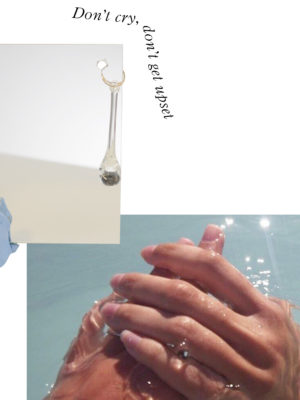
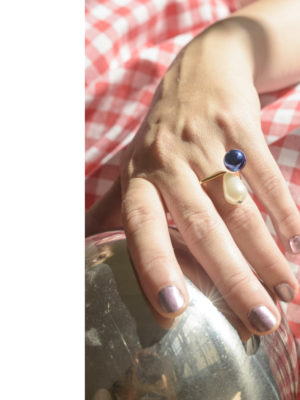
This article was first published in the #6 Current Obsession Paper for New York City Jewelry Week
